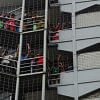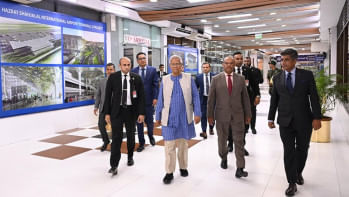Bracing for a tariff storm

There are mornings when the news feels like a personal blow. As I sat at my desk last week, the headline about the United States imposing a 37 percent tariff on Bangladeshi exports—particularly garments—struck me with a strange mix of disbelief and dread.
Not just as a banker who supports countless businesses involved in international trade, but as a Bangladeshi who has watched our country rise from the margins of global commerce to become the second-largest exporter of RMG in the world.
I thought of the thousands of women working under fluorescent lights in Narayanganj and Gazipur, of exporters who've built empires stitch by stitch, and of factory owners who have staked their futures on long-term US orders.
In trade, as in life, one decision from far away can unravel years of careful effort. Seneca said: 'A gem cannot be polished without friction, nor a man perfected without trials.' We are being tested here. That was the most overpowering feeling that hit me in the face.
Before we go any further, let's begin at the beginning. Let us try to understand what this tariff truly means for us.
Understanding tariffs
A tariff is a tax imposed on goods entering a country. When the US levies a 37 percent tariff on Bangladeshi garments, American importers must pay that extra amount, often passing the cost along the chain: US companies might raise prices for consumers or demand lower prices from Bangladeshi exporters. In simple terms, tariffs make foreign products more expensive, protecting domestic industries but hurting foreign sellers. For importers (like US retailers), a tariff increases the cost of buying from abroad, which can lead to pricier goods in shops or a switch to cheaper suppliers.
For exporters (like Bangladeshi factories), tariffs make their products costlier in the destination market, which can reduce demand for their goods or force them to accept lower profit margins to stay competitive. In short, tariffs can be a double-edged sword—a policy tool that might help one country's producers, but often at the expense of local consumers and producers in another country.
Previously, Bangladesh's apparel exports to the US faced an average duty of around 15 percent. With the new tariff, some categories now face over 50 percent total duty, making them significantly more expensive in the US market.
The move is part of a broader strategy by the Trump administration to target the countries it believes impose higher duties on US products. While some logic underpins this argument, its implementation risks severely disrupting economies like ours that are heavily export-dependent.
Why Bangladesh is particularly vulnerable
Bangladesh's economy is uniquely exposed to such a shock. The ready-made garment (RMG) sector accounts for over 80 percent of our export earnings, contributes around 10 percent of GDP, and employs more than four million workers—most of them women.
The United States is our single largest export destination. In 2024, Bangladesh exported goods worth over $8.4 billion to the US, with $7.3 billion of that from the garment sector. Some of our factories depend almost entirely on American orders.
With a 37 percent tariff, many US retailers may now shift to sourcing from countries like India or Mexico, which face lower duties. Even a 10 percent difference in costs can sway buyers in a highly price-sensitive industry.
This creates a perfect storm: fewer orders, factory slowdowns, possible layoffs, and reduced foreign exchange earnings—all of which could strain our economy just as it seeks stability.
Ripple effects on the economy
The immediate concern is the impact on export earnings. Ready-made garments have long driven Bangladesh's growth. A drop in US orders due to the tariff would hit overall export revenue and reduce dollar inflows, potentially leading to a foreign exchange crunch.
Our economy relies on these dollars to pay for essential imports like cotton, machinery, and fuel, and to maintain currency reserves. A sustained decline in exports could weaken the taka and widen the trade deficit. As a banker, I worry that this may create a dollar shortage, making raw material imports harder and exchange rates volatile.
Job losses are another major concern. Millions work in garment factories, most of them women. For many, sewing jobs offer a route out of poverty. If US brands cancel or cut orders, factories may scale down or close. Industry leaders warn this tariff could shift buyers to other countries. I've spoken to factory clients bracing for layoffs if US contracts stop. Just last year, over half a million mostly female garment workers lost jobs during global disruptions. A shock like this could worsen that trend.
The ripple effects go beyond factories. The garment industry supports a wide network: textile mills, button and zipper suppliers, packaging firms, and transport providers. Shrinking orders will hurt them too. The investment climate is also at risk. With hopes pinned on export-led growth, a sudden tariff adds uncertainty. Investors may pause expansion or redirect funds to 'safer' countries. If the situation remains unchanged, we risk losing jobs, deterring investment, and slowing our GDP growth.
Why this tariff hits us so hard
The US tariff hike is part of a broader 'reciprocal tariff' policy affecting multiple countries. While China, Vietnam, Cambodia, and Sri Lanka face even higher rates, Bangladesh's 37 percent tariff is still among the steepest in South Asia—second only to Sri Lanka. What makes it especially damaging is our heavy reliance on garment exports. The US imported $8.4 billion in Bangladeshi garments last year—roughly 20 percent of our total RMG exports and about 21 percent of all exports. Losing a large share of this due to reduced competitiveness would be a major economic blow.
Not all countries are hit equally. India, for example, faces a lower US tariff of 27 percent, making it a more attractive sourcing destination for American importers. In a price-sensitive industry like apparel, even small cost differences can shift major orders. Industry voices, like Anwar-ul-Alam Chowdhury, warn that Bangladesh will be among the hardest hit. Some US retailers have already paused new orders from Bangladesh to assess the tariff's impact—our loss could quickly become another country's gain.
There's also a diplomatic dimension. Bangladesh benefits from reduced-tariff access in markets like the EU under the 'Everything But Arms' scheme. We once hoped for similar US treatment, but the US removed Bangladesh from the GSP in 2013 over labor concerns. While apparel was never part of GSP, its loss still hurt. Now, instead of progress, we face this 'super-tariff.' It feels like a setback in US-Bangladesh trade ties.
While the US argues that this tariff corrects global trade imbalances, it may ultimately backfire. Bangladesh is not an industrial giant like China. We are a developing country, still navigating political, social, and economic transformation. The RMG sector—especially post-Rana Plaza—has become a global symbol of improvement and resilience. Punishing a country that employs millions of low-income workers—particularly women—risks harming those very communities the global development community has sought to uplift.
What Bangladeshi exporters can do
In response to the tariff, Bangladeshi exporters are already working on ways to adapt. One immediate step is renegotiating contracts with US buyers to share the cost burden. Exporters may offer slight discounts, while buyers accept reduced margins or pass small price hikes to consumers. Open dialogue and smart negotiations are vital to prevent buyers from pulling out. This is a time for win-win compromises to maintain order volumes.
Another strategy is accelerating market diversification. Over-reliance on the US has long been a vulnerability. While efforts are already underway to grow exports to the EU, Canada, Japan, and emerging markets like China and Latin America, this tariff is a wake-up call to expand those efforts. Europe, which buys more Bangladeshi garments than the US, offers favourable trade terms. Other markets in Asia, the Middle East, and Africa also hold promise. Diversifying doesn't have to mean abandoning the US
Upgrading the value chain is also gaining traction. Competing solely on low cost is no longer enough. Exporters are being encouraged to move into higher-end, value-added garments, invest in design and branding, and improve compliance and sustainability standards. Some firms are already using advanced technology and producing complex items like sportswear. Sustainable production can also attract buyers who value more than just price.
Lastly, industry unity is key. BGMEA, BKMEA, and other groups are lobbying the government, coordinating data, and engaging with US counterparts to oppose the tariff. As a banker working closely with exporters, my minimum expectation is to see them doing intense collaborative brainstorming. These industry bodies may even reach out to counterpart organizations in the US (like the American Apparel and Footwear Association) to build a case against the tariff. The message is clear: we've overcome past crises—from Rana Plaza to the pandemic—and we can do so again by acting fast. Overall, it's about adapting quickly: finding new buyers, improving products, cutting unnecessary costs, and negotiating hard.
What the government should do
While businesses adjust, strong government action is critical. The tariff challenge is as much political as economic. Bangladesh must urgently open formal talks with US counterparts to seek relief or exemptions. Trade officials—even the Chief Adviser's office—should make the case that this tariff hurts a key ally and a developing country that imports US goods like cotton duty-free. Diplomatic outreach should also involve US retailers and fashion brands who rely on Bangladeshi suppliers. Encouraging dialogue between them and US trade officials could help find a compromise.
Bangladesh can also coordinate with other affected countries such as Vietnam and Sri Lanka to raise concerns at platforms like the WTO. A united front adds weight. Support from trade partners like the EU or UK can be leveraged to advocate for fairer treatment from the US, as they too have a stake in global trade stability.
In the longer term, Bangladesh should push for more formal trade protection through agreements—such as a Free Trade Agreement or inclusion in a revived GSP program. Since GSP never covered garments, a broader and more inclusive trade deal is needed. To support this effort, Bangladesh must also address US concerns, especially around labor rights and factory conditions.
While some voices suggest retaliatory tariffs on US goods, this approach carries risks. Bangladesh relies heavily on US imports like cotton and machinery, and retaliation could hurt our own industries more than it pressures the US Still, having such measures quietly prepared can serve as negotiating leverage, to be used only as a last resort.
Domestically, the government should provide immediate support to affected industries. Relief measures like tax breaks, credit support, or temporary financial aid can help factories absorb the shock. If layoffs happen, retraining programs and income support—especially for women—will be essential to protect livelihoods and prevent social fallout.
Finally, Bangladesh must reduce over-dependence on garments. Within the RMG sector, incentives for higher-value products and local textile production can increase resilience. At the same time, expanding other export sectors like pharmaceuticals, IT services, leather goods, and agro-products will help cushion the economy against future shocks.
Moving forward
As I write this, both as a banker and a concerned Bangladeshi, I feel the weight of the 37 percent US tariff on our exports—a jarring reminder of how exposed we are to global forces. Yet amid the concern, I also sense a collective resolve. The path ahead won't be smooth, but our nation has never been one to surrender to setbacks. That same spirit must now fuel our response. We need to innovate in production and negotiate strategically on the world stage, reminding our partners that punitive tariffs on a country like ours hurt the very communities global development seeks to empower.
Bangladesh's best insurance is to be prepared. Like what we do in banking, we must spread our risk—finding new buyers, moving up the value chain, and future-proofing our economy. This tariff is a setback, but not the end of our story.
Mashrur Arefin is the managing director & CEO of City Bank PLC and a renowned author in the Bangla language.

 For all latest news, follow The Daily Star's Google News channel.
For all latest news, follow The Daily Star's Google News channel. 










Comments